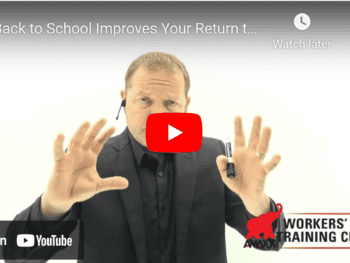The Link between Worker’s Comp and the ADA
In 2009, The U.S. Equal Employment Opportunity Commission (EEOC) announced a record-setting consent decree settling a class action lawsuit against Sears, Roebuck and Co. under the Americans with Disabilities Act (ADA) for $6.2 million. The EEOC’s suit alleged that Sears maintained an inflexible workers’ compensation leave exhaustion policy and terminated employees instead of providing them with reasonable accommodations for their disabilities, in violation of the ADA.
This case highlights the importance of having a proactive return to work program that addresses the ADA accommodation requirements. When employees are injured on the job, employers must have a plan that addresses return to work options and ADA accommodations.
Return to Work Strategies
Normally, when employees are released to work following a worker’s comp injury, they will return to their previous position. However, employees may have an occupational injury or illness where they are released to work but can’t perform all of the essential functions of their regular job or need an accommodation.
When creating return to work opportunities consider several strategies. Think “out of the box” in your approach to getting employees back to the workforce. There are many tasks to keep workers productive and involved in the workforce.
1-Prepare a physical binder
Create a binder full of alternative job descriptions within the company or sister companies that employees can easily access. Have Human Resources regularly update the binder with all job openings, full and part time, temporary and permanent. Make sure the supervisor and the employee are aware of the binder and regularly check it for openings.
2-Promote internal online job listing resources
As with the physical binder, make sure there is an on-line job listing resource that the employee can access. Email all job openings to the employee in addition to what is available in the physical binder.
3-Create a return-to-work resource center
Have your Human Resources Department encourage the injured employee that they are wanted back at work. Make sure that HR is a resource to support the employee in creatively finding a way to return to work, even if it is in another position more compatible with the employee’s limitations. Have HR consult with the employee about any reasonable accommodations that would make it possible for the employee to return to work in any available positions. Have a written Return to Work Policy so that all management and supervisors understand the goals and methods of having employees successfully return to work.
4-Consider outside resources to accommodate transitional duty workers
Vocational rehabilitation (voc rehab). Voc rehab is a federally funded agency in every state that offers vocational rehabilitation, employment opportunities and independent living services for disabled people. The programs vary by state but may include medical, psychological and vocational assessments, counseling services, therapy, training, job placement and rehabilitation.
The Job Accommodation Network (JAN) provides free consulting services to employers. Services include one-on-one consultation about all aspects of job accommodations, including the accommodation process, accommodation ideas, product vendors, referral to other resources, and ADA compliance assistance. JAN has several on-line tools and publications to help employers accommodate employees with a disability.
Occupational Health and Safety Administration (OSHA) regulates safety compliance in the workplace. In some instances, OSHA safety regulations may prevent certain accommodations for an injured employee. OSHA has a website that employers can consult for guidance. Sometimes OSHA will publish bulletins with innovative safety accommodation ideas, e.g. how to safely accommodate employees with hearing loss injuries. http://www.osha.gov/dts/shib/shib072205.html.
5-Encourage volunteerism and partner with local employment agencies or volunteer groups to enhance workers’ options.
Often employers want to offer modified duty but do not have appropriate positions available. Some states have Workers Compensation Funds that have partnered with charitable organizations to offer a return-to-work plan that provides modified duty for injured employees. These plans can lower claims costs, decrease workers’ compensation insurance costs and increase morale.
In addition, employers who do not have an appropriate positions available may want to partner with local employment agencies that may have appropriate temporary or permanent positions available for the employee.
6-Consider home-based employment
Telecommuting may be a reasonable accommodation under the ADA for an injured or ill worker. Have HR consult with the supervisor and the employee to see if there are any tasks that the employee can perform from home on a temporary or permanent basis.
Author Rebecca Shafer, JD, President of Amaxx Risk Solutions, Inc. is a national expert in the field of workers compensation. She is a writer, speaker, and publisher. Her expertise is working with employers to reduce workers compensation costs, and her clients include airlines, healthcare, printing/publishing, pharmaceuticals, retail, hospitality, and manufacturing. She is the author of the #1 selling book on cost containment, Workers Compensation Management Program: Reduce Costs 20% to 50%. Contact: RShafer@ReduceYourWorkersComp.com.
Editor Michael B. Stack, CPA, Director of Operations, Amaxx Risk Solutions, Inc. is an expert in employer communication systems and part of the Amaxx team helping companies reduce their worker’s compensation costs by 20% to 50%. He is a writer, speaker, and website publisher. www.reduceyourworkerscomp.com. Contact: mstack@reduceyourworkerscomp.com.
WORKERS COMP MANAGEMENT MANUAL: www.WCManual.com
Do not use this information without independent verification. All state laws vary. You should consult with your insurance broker or agent about workers comp issues.
©2012 Amaxx Risk Solutions, Inc. All rights reserved under International Copyright Law. If you would like permission to reprint this material, contact us at: Info@ReduceYourWorkersComp.com.















